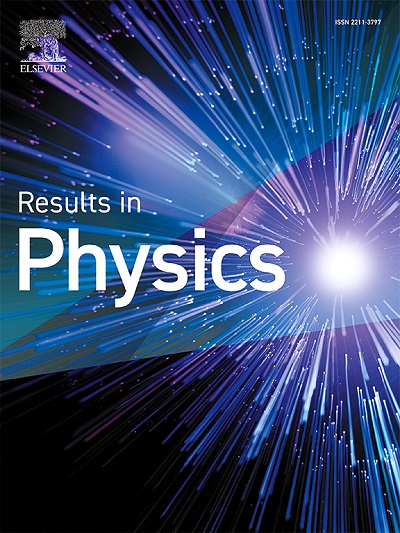Neural network prediction of MHD thermo-solutal natural convection in ternary hybrid nanofluids within a curved enclosure
IF 4.4
2区 物理与天体物理
Q2 MATERIALS SCIENCE, MULTIDISCIPLINARY
引用次数: 0
Abstract
In an era when optimizing energy efficiency and ensuring effective thermal management are essential, this study addresses the complex dynamics of MHD thermo-solutal natural convection (TSNC) within a curved cavity containing a unique ternary hybrid nanofluid (THNF) (Cu + CuO + Al2O3/H2O). We explore the effects of key parameters, including Rayleigh number (Ra: 104–107), Hartman number (Ha: 0–100), volume fraction of nanoparticles (ϕ: 0–0.04), Lewis number (Le: 1–10), heat source length (H: 0.2–0.6), and heat source location (R: 0.25–0.75), on convective flow patterns, heat transfer, and mass movement. An artificial neural network (ANN) model is developed to investigate the influences of these parameters on the thermal and solute transport properties of THNF. The ANN model is trained using high-fidelity numerical simulation data to predict the thermosolutal convection behavior of THNF. This methodology accelerates predictive analysis but requires significant computational effort for training. Our precise representation of streamlines, isotherm lines and concentration profiles reveals that complex relationships between these variables. The results demonstrate that higher the values improve heat and mass transfer, whereas increasing Ha suppresses convective motion due to electromagnetic damping from the Lorentz force. Increased enhances heat and mass tranfer, leading to stronger convection. analysis reveals that elevated values promote mass transfer over heat transfer. Although variation in heat source parameters affects flow structure and thermal gradient differently, the overall convective behavior depends on their interplay. Our comparison research show that the ternary hybrid nanofluid () exhibits a higher average Nusselt number compared to the base fluid, the ternary hybrid nanofluid shows an increase in heat transfer efficiency of up to 78.33 % under specific conditions. These findings emphasize the potential of THNF and the modification of operational parameter, giving important insights for improving heat and mass transfer technologies across diverse industries.
弯曲外壳内三元混合纳米流体MHD热溶质自然对流的神经网络预测
在优化能源效率和确保有效热管理至关重要的时代,本研究解决了包含独特三元混合纳米流体(Cu + CuO + Al2O3/H2O)的弯曲腔内MHD热溶质自然对流(TSNC)的复杂动力学。我们探讨了关键参数,包括瑞利数(Ra: 104-107)、哈特曼数(Ha: 0-100)、纳米颗粒体积分数(φ: 0-0.04)、刘易斯数(Le: 1-10)、热源长度(H: 0.2-0.6)和热源位置(R: 0.25-0.75)对对流流动模式、传热和质量运动的影响。建立了人工神经网络(ANN)模型,研究了这些参数对THNF热和溶质输运性质的影响。利用高保真数值模拟数据对人工神经网络模型进行训练,预测THNF的热溶质对流行为。这种方法加速了预测分析,但需要大量的计算训练。我们对流线、等温线和浓度曲线的精确描述揭示了这些变量之间的复杂关系。结果表明,较高的Ra值改善了传热和传质,而增加的Ha由于洛伦兹力的电磁阻尼而抑制对流运动。增加的ϕ增强了热量和质量传递,导致更强的对流。分析表明,升高的数值促进了传质而不是传热。虽然热源参数的变化对流动结构和热梯度的影响不同,但整体对流行为取决于它们的相互作用。对比研究表明,三元杂化纳米流体(Cu+CuO+Al2O3)的平均努塞尔数比基液高,在特定条件下,三元杂化纳米流体的换热效率可提高78.33 %。这些发现强调了THNF的潜力和操作参数的修改,为改善不同行业的传热传质技术提供了重要的见解。
本文章由计算机程序翻译,如有差异,请以英文原文为准。
求助全文
约1分钟内获得全文
求助全文
来源期刊

Results in Physics
MATERIALS SCIENCE, MULTIDISCIPLINARYPHYSIC-PHYSICS, MULTIDISCIPLINARY
CiteScore
8.70
自引率
9.40%
发文量
754
审稿时长
50 days
期刊介绍:
Results in Physics is an open access journal offering authors the opportunity to publish in all fundamental and interdisciplinary areas of physics, materials science, and applied physics. Papers of a theoretical, computational, and experimental nature are all welcome. Results in Physics accepts papers that are scientifically sound, technically correct and provide valuable new knowledge to the physics community. Topics such as three-dimensional flow and magnetohydrodynamics are not within the scope of Results in Physics.
Results in Physics welcomes three types of papers:
1. Full research papers
2. Microarticles: very short papers, no longer than two pages. They may consist of a single, but well-described piece of information, such as:
- Data and/or a plot plus a description
- Description of a new method or instrumentation
- Negative results
- Concept or design study
3. Letters to the Editor: Letters discussing a recent article published in Results in Physics are welcome. These are objective, constructive, or educational critiques of papers published in Results in Physics. Accepted letters will be sent to the author of the original paper for a response. Each letter and response is published together. Letters should be received within 8 weeks of the article''s publication. They should not exceed 750 words of text and 10 references.
 求助内容:
求助内容: 应助结果提醒方式:
应助结果提醒方式:


